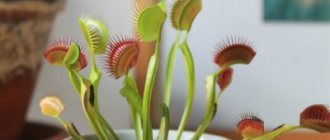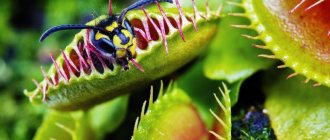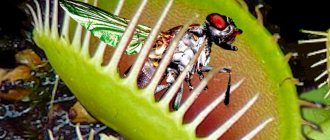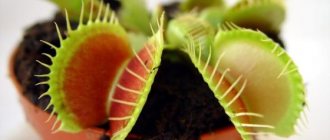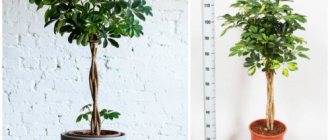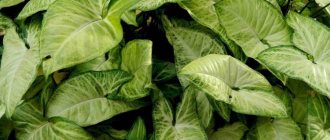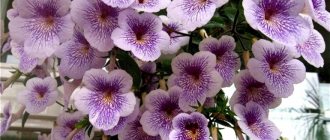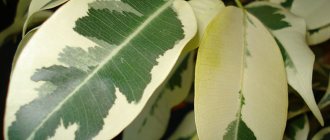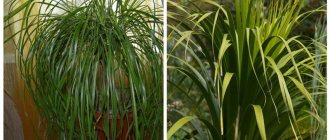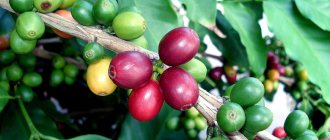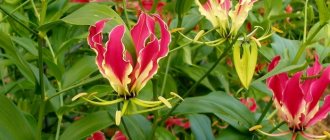On March 8, the predatory Dionaea was bought almost more often than tulips. And of course, there were many questions about caring for this amazing plant. This once again prompted us to think about a blog where we will publish advice from Jungle salon biologists on caring for the most popular indoor plants. This time we were able to materialize thoughts into text, so we start with a useful article about flycatchers.
Dionaea or Venus flytrap (lat. Dionaea muscipula) is a carnivorous plant native to the swamps of the South Atlantic states of America. It belongs to the same family as Sundew, which grows in Belarusian swamps. The peculiarity of predator plants is that they not only obtain energy through photosynthesis, like all plants, but are also able to feed on small insects. With their insect treats, they mainly compensate for the lack of nitrogen in the marshy soils in which they grow in the wild.
By the way, the Dionea that grows in the swamps of America is in danger of extinction. The same cannot be said about indoor flycatchers: in recent years they have become one of the most popular indoor plants around the world, although they are quite finicky.
7% discount using promo code “Vesna”! Especially for our blog readers.
Venus flytrap: how to get seeds?
Venus flytrap seeds
Venus flytrap seeds can be purchased in specialized stores or obtained from an adult plant. Dionaea begins to bloom in spring. During this period, white flowers form on the peduncles.
At home, natural pollination is almost impossible. In order for the seeds to set, it is necessary to pollinate the flower artificially. The procedure is usually performed two days after the opening of the buds. To do this, you need to collect pollen with a small brush and transfer it to the pistil.
To grow a predatory flower from seeds, they must be of high quality, black in color, with a smooth, shiny surface. Store them in paper bags in the refrigerator. When purchasing planting material in retail or online stores, you should pay attention to the release date. It is worth remembering that they remain viable for up to one year.
Diseases
Dionaea is resistant to diseases and pests . Sometimes it is affected by root or leaf rot. This happens from excessive moisture in the soil and surrounding air. Despite the fact that the flower loves moisture, it should not be flooded. You should also avoid getting water on its leaves.
Usually pests do not touch the Venus flytrap. Even when kept outdoors for a long time, harmful insects avoid it.
Venus flytrap: stratification, description of the process
Seeds on gauze: preparation for stratification
To speed up the germination of plant seeds, and they germinate more easily, before sowing, it is necessary to imitate the effects of winter weather conditions, which means keeping them at a low temperature. The duration of the seed stratification process is 1.5–2 months.
The seeds should be spread out on damp gauze, transferred in this form to a plastic container or other container and placed in the refrigerator compartment of the device. During the stratification period, the fabric must be damp. It can be moistened with a solution of potassium permanganate and fungicide.
Watering
Requires abundant watering during the spring and summer. The soil in the pot with the plant should not dry out, as this immediately leads to the death of Dionaea.
In winter, during the dormant period, Dionaea is watered very rarely. However, the soil in the dionaea pot in winter should be slightly moist and not dry out.
Water the plant with soft water. Rainwater is best suited for this purpose. Watering with moderate and hard water will lead to disease and death of the plant.
Water for irrigation should be 1-2 degrees warmer than the surrounding air. It is best to water by immersing the pot in 1/3 water for half an hour.
Preparing the soil for planting a Venus flytrap
Substrate for growing a Venus flytrap
The predator flower in nature grows in swampy areas, so for cultivation at home it needs a special substrate.
Three options for compositions for growing Dionaea:
- Perlite, quartz sand, sphagnum or peat in a ratio of 1:2:3.
- High peat, sand and perlite (2:1:1).
- A special mixture that promotes rooting of cuttings, combined with peat (1:2).
Before use, perlite must be boiled in distilled water to prevent soil salinity.
Spraying
The plant is sprayed only in spring and summer. Do this 2-3 times a week. For this procedure, use a water spray to humidify the air near the plant, but wet its leaves as little as possible.
Due to excessive moisture of the leaves of the plant, they may rot . It is best to use soft rain water for spraying.
During the dormant period, Dionaea is not sprayed. At low temperatures, excessive moisture will cause the development of fungal infections.
Venus flytrap: methods of reproduction, photos
So, how to grow Dionaea? If there is already this plant in the house, then new ones can be obtained from the seeds of an adult flower, by dividing the bush and cutting leaves.
Dionaea propagation by leaf cuttings
Photo and description of the process of propagation of the Venus flytrap plant by seeds
For this method of breeding a predator, it is recommended to make a small heated greenhouse. When sowing, you do not have to maintain a certain distance between the seeds, since, as a rule, only part of them germinates.
Instead of a greenhouse, you can use a simple box for growing seedlings. After embedding the material into the substrate, cover the container with film or glass and place it in a well-lit place. In order not to disturb the humid microclimate in a homemade greenhouse, watering should be carried out through the bottom.
Next, you need to plant the flower sprouts in separate pots with soil mixture for adult plants. They bloom in the second or more years of life.
Ripe seeds from Venus flytrap pods
The optimal temperature for seed germination is 25–29ºС. If all conditions are met, they will hatch in two weeks.
For the seed propagation method, you can use seeds of plants that have survived at least one winter. In young flowers, it is recommended to remove the peduncle. The ovaries will appear in a month. Next, boxes are formed in which from 20 to 30 seeds ripen at the same time.
Dionaea is not a plant from which you can regularly obtain seeds. If the condition of the flower becomes worse, it means that it is exhausted and needs to be given time to rest.
Reproduction by dividing the bush
The formation of several growth points in the Venus flytrap indicates its aging and the need to divide the bush. A favorable time for this event is in the spring, during active growth. To do this, you need to remove the flower from the pot, remove the soil from the roots and divide it into several parts. Then the resulting material should be planted in individual containers.
How to propagate a Venus flytrap by leaf cuttings
The right time for the procedure is spring. For propagation, you need to cut off the traps with a knife and you need the number of leaves with a white part. After this, they should be placed in a growth stimulator for 20 minutes.
For rooting, the leaves of Dionaea flycatcher are placed in boxes or plastic containers for seedlings with a mixture of quartz sand and high peat, layer height is 2 cm. Then water the substrate with a solution of some fungicide. To prepare it, you need to use only distilled water.
As parts of the flower take root, the leaves of the mother plant will gradually die off, and small rosettes will form in their place. When the sprouts become stronger, they need to be planted in separate containers with soil for adult plants.
Features of home care
The insectivorous plant is quite capricious. But if you provide it with the right care, it will grow and develop magnificently.
Location and lighting
One of the main conditions for maintaining the good health of Dionaea is bright lighting (it should be diffused), natural or artificial. In the morning and evening, the exotic needs direct sunlight. In poor light, the leaves turn pale and stretch out.
The ideal place for a tropical predator is a window “looking” to the west or east. A southern window sill would also be an excellent choice, but at midday you will have to shade the flower.
You should not often unwrap the Dionaea, as this will have a stressful effect on it.
Plants located in the florarium require additional lighting. A phytolamp is hung above the flower (at a height of about 20 centimeters) to provide 14–16 hours of daylight.
Temperature
The flycatcher belongs to heat-loving plants. During the growing season, the optimal temperature is 22–30⁰С, possibly increasing to 35–38 degrees, which does not affect growth and development. But such a temperature should not be maintained all year round; in winter it is necessary to lower it to 8 degrees.
Dionaea does not tolerate stagnant air. Therefore, systematic ventilation is necessary, but without drafts.
In summer, if possible, Dionaea should be taken outside. In this case, you won't have to feed her. The predatory plant will provide itself with food by hunting insects and spiders.
How to water
Exotic requires a high level of humidity, which is why it is best to keep it in a florarium.
The soil in the pot should not dry out, which could cause the death of the traps. To ensure that the flower receives a sufficient amount of water, it is advisable to place it in a tray filled with water.
If top watering is used, it is recommended to cover the soil with a layer of sphagnum to prevent soil compaction and ensure oxygen supply to the roots.
In summer, Dionaea needs to be sprayed regularly.
In nature, the insectivorous plant grows on very poor soils, as a result of which the roots have lost the ability to absorb mineral elements. Therefore, water the exotic plant with rain, distilled or filtered water, but not with tap water.
What to feed a flycatcher
Insects and spiders serve as food for the predator - they replenish the plant's lack of nitrogen. The victims must be alive (the valves react to movement) and small (they must occupy no more than a third of the internal space of the trap, otherwise the valves will not be able to close).
Dionea should not be given to beetles covered with hard chitin, as well as gnawing insects - they can turn from victims into pests and damage the trap. Feeding meat is strictly contraindicated, as it will lead to rot and the development of diseases.
The predator eats organic matter only when it is hungry. If you overeat, Dionaea can get sick. Therefore, they feed it no more than twice a month, placing food in different traps each time.
Please note that:
- large insects take longer to digest than small ones;
- in old traps, digestive juices are formed more slowly than in young ones;
- In the cold, the digestion process slows down.
Do not tease the plant again by touching the trap. If the valves close frequently without receiving protein food, they will soon lose their functionality and turn black.
You cannot feed a flower if it:
- ill or severely weakened;
- have recently undergone a transplant or experienced stress;
- grew in poor light or excessively high humidity.
In the last days of September, Dionea stops giving organic food.
Soil and pot
To prepare the soil substrate, mix quartz sand (perlite can be used instead) with double the amount of peat. The sand must first be boiled in distillate, and the perlite must be kept in water for a week, replacing it periodically.
If you plant an insectivorous plant in nutritious soil, it will get sick.
The pot should be chosen not wide (with a diameter of no more than 12 centimeters), but deep - the roots penetrate 20 centimeters deep. It is advisable that it be light - a dark color attracts sunlight, which can lead to overheating of the roots.
Despite the fact that tropical exotic loves heat very much, its roots suffer from overheating.
Planting and transplanting
The flycatcher is replanted as needed, preferably in the spring. When transplanting, you must act very carefully so as not to damage the fragile roots. First, the plant is removed from the old pot and the soil is shaken off from the roots. If the substrate adheres tightly to the roots, then place them in water for a couple of minutes. Then the bush is placed in a pot and covered with soil mixture without tamping. Well watered.
A drainage dione is not needed.
After transplanting, the predator should be left for a month in a dark, warm place, providing abundant watering. Such conditions will help the plant adapt.
Bloom
The tropical beauty is very small, its height is 10–15 centimeters, and its peduncle grows up to half a meter in height. Therefore, flowering takes a lot of energy from a plant (especially a young one) and slows down the process of trap formation, which is why it is recommended to cut off flower stalks immediately after appearance. If seeds are needed, then leave the buds.
Fertilizers
The predator does not need traditional fertilizers; it receives all the elements it needs for life from the insect’s body.
Venus flytrap in winter
In autumn, Dionaea stops producing leaves and prepares for “sleep”. To help the plant, it is removed from the tray and transferred to a darkened and fairly cool (8–10 degrees Celsius) room. The flycatcher can spend the winter on an insulated loggia or in the basement. You can place it in the lower section of the refrigerator.
Do not throw away Dionaea if the leaves turn brown and fall off in the fall - it will overwinter in this form. In spring the plant will restore its decorative appearance.
In winter, the predator does not need either lighting or food. Therefore, feeding is stopped, watering is reduced to a minimum - stagnation of water will cause rotting of the roots.
With the arrival of the first spring days, the dionaea is returned to its original place and all traps are removed from it. Gradually resume previous care.
Transplanting a Venus flytrap
The flower needs to be replanted in the spring. The frequency of the event is once every two years.
The plant must be carefully removed from the container, without violating the integrity of the root system, and all substrate must be removed from the roots, since harmful salts that fall with water during watering can accumulate on them. Then you should transplant the flower into a new pot with clean soil, pre-moistened and disinfected with Maxim or Topaz. After planting, the substrate should be sprinkled with colloidal sulfur. It is also recommended to treat the flycatcher with Epin a couple of days before transplanting.
Fertilizer
You should not get carried away with feeding the Venus flytrap. Excess fertilizer in the soil leads to the death of the root system.
Therefore, this plant is fed 2-3 times a season or not fed at all.
We must not forget that Dionaea is a predatory flower . She compensates for the lack of nutrition by eating protein foods. Therefore, the best feeding for it is live insects. But the Venus flytrap is not fed often - 3-4 times a season. They use flies, mosquitoes, and if they are not there, small pieces of meat.
Varieties and varieties
Dionea is a monotypic genus. In simple terms, there is only one type. However, there are many varieties of it. Let's list just a few of them.
| Variety | Description |
| Dionaea, which has a diameter of eleven centimeters, plus or minus one centimeter. There are five to twelve traps on the plant. The flower is usually green. There is a red stripe running along the outside of the traps. Their internal cavity is also painted red. Foliage and traps stand upright. |
| Giant | A variety with a green leaf rosette. Traps larger than five centimeters grow quickly. If the light is bright, they appear bright purple. |
| Akai Riu | This Dionaea's foliage and traps are dark red, regardless of the brightness of the light. On the outside of the traps you can see a green stripe. |
| Regyula | Variety with green foliage. Purple and red traps alternate between each other. |
| Bohemian Garnet | A dense green plant, reaching twelve centimeters in diameter. There are five to twelve horizontally located traps on it. The foliage is wide and covers the soil. |
| Funnel Trap | This plant is green when young. The petioles do not change color with age, but the traps turn red. Each flower has a pair of traps that differ in structure. |
| Crocodile | Young representatives of this variety are almost completely green, and the internal cavity of the traps is pinkish. Then the traps turn red. The foliage is horizontal. |
| Triton | Green Dionaea. The variety differs from the others in its special shape of traps. These parts of the plant are elongated and cut only on one side, and it happens that the teeth stick together. |
| Dracula | Green plant except for the red interior of the traps. The traps have short teeth with a red stripe at the base. |
Wintering the plant
By the onset of October, it is necessary to stop feeding Dionaea. She is already tired and begins her part of the preparations for winter. Visually, this can be seen by the fact that new leaves stop appearing, and old ones turn black and fall off, in the process the rosette becomes smaller. Then the plant should not be fed until the end of winter. It consumes less and less water, and less water can be kept in the pan. Watering is still required, but not as often and less abundantly. The main thing is that the soil remains at least a little moist. In winter, it is also necessary to take care of the soil.
Important! If it becomes too wet or too dry, the Dionaea will die.
With the onset of December, the plant should be moved to a cooler place, while some lighting is allowed. The temperature should be between 2-10 degrees. Sometimes the pot needs to be taken out to the basement. It would be a good idea to put it in a plastic bag and then store it at the bottom of the refrigerator. A glass loggia is also suitable for preserving dionaea in a bag. In such a cool place, a flower pot placed in a bag will be stored for three or four months. This is how long the hibernation of Dionaea lasts. In February it’s time to return it back to the warmth and light. Then you need to immediately cut off last year's traps. It is also important to continue caring for the plant. It is necessary to carefully maintain the humidity and temperature suitable for Dionaea, water it, and spray it. And only by the beginning of June can we expect that Dionaea will begin to grow rapidly again.
In winter, the plant should be kept indoors, where the temperature is 2-10 degrees
A full winter will ensure the plant a long life.
Problems
A common problem when growing dionaea is yellowing and dying of its leaves. This happens for various reasons.
Typically, leaves turn yellow due to diseases of the root system. And the most common reason for this is waterlogging. But sometimes the roots suffer due to excess nutrients. With frequent feeding with mineral fertilizers, they may even begin to die.
It should be remembered that you only need to feed the Venus flytrap with insects . Feeding with fertilizers is carried out extremely rarely.
If the leaves begin to turn yellow but do not fall off, this is a sign of watering with hard water. Water for watering the flycatcher should be very soft rainwater.
The trapping leaves of the plant should not be irritated. They can only close 2-3 times and then die. If you close these traps, the plant may very soon be left with no foliage at all. You need to handle this exotic flower very carefully and do not touch its leaves without reason.
